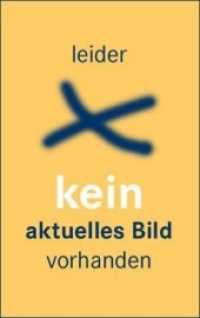Full Description
Intended for use in childcare, preschool, Head Start, and with children in kindergarten and early primary grades, the latest in the Active Experiences series is based on the most recent, nationally recognized research regarding children's approaches to learning as well as current NCTM curriculum guidelines for mathematics. The content is clear and concise, with practically applied chapters on ways to guide children's mathematical thinking and learning. Key topics involve group work, investigations, and projects; are grounded in children's interests and needs; and, build, one upon the other to form a coherent learning curriculum. Additionally, each reflects the most recent standards of the National Council of Teachers of Mathematics (NCTM) and the National Association for the Education of Young Children (NAEYC). This edition has been thoroughly revised to include updated Home-School Connection features that illustrate various ways to support children's daily learning of mathematics; more developmentally appropriate and intentional assessment guidance than ever before; research-based guides explaining children's cognitive and skill development in all math content areas, based on the Learning Trajectories Approach; and a new technology resource found at the end of every chapter.
Contents
PART ONE THEORY OF ACTIVE EXPERIENCES
1 Experiences and Mathematics in Early Childhood: Theory into Practice
Deep Personal Meaning
Firsthand Experiences
Initiative, Choices, and Decision Making
Developmentally Appropriate
Content with Meaning and Integrity
Involving Others
Play
Group Work and Projects
Interactions with Teachers and Other Adults
Covered with Language
Continuity of Learning
Time to Reflect
Organization
Observation and Assessment
Summary
2 Active Children, Active Environments
The Essentials
Beauty
Space
Aesthetics
Indoor Spaces
Integrating Spaces
Math or Manipulative Areas
Science Areas
Art Centers
Woodworking Centers
Book and Library Centers
Sociodramatic Play Areas
Block Areas
Water and Sand Areas
Music Areas
Computer Stations
Quiet Spaces
Outdoor Spaces
Math/Science and Nature Discovery Areas
Art Spaces
Physical Spaces
Other Spaces
Planning for Inclusion
The Teacher's Role
Summary
3 Building Connections to Home and Community Through Active Experiences
Out into the School
Inside the School Building
Outside in the Natural Environment
Out into the Neighborhood and Community
Basic Guidelines for Meaningful Field Experiences
Building Connections with the Neighborhood and Community
The Neighborhood as a Mathematics Laboratory
Neighborhood Resources
The Home—School Connection
Summary
4 Connecting Everyday Experiences with Mathematical Content
Knowledge of Children
Knowledge of the Subject Matter: Mathematics
Principles for Teaching Mathematics
NCTM Standards
Curriculum Focal Points and Connections
Using Knowledge of Mathematics to Guide Children's Development
Expanding and Extending Firsthand Experiences
Summary
Part TWO Guides to Active Experiences
5 Developing Ideas of Number and Operations
For the Teacher
What You'll Need to Know
Key Concepts
Goals and Objectives
What You'll Need
The Home—School Connection
Documenting and Assessing Children's Learning
For the Children
Learning About Numbers and Counting
Reflecting
Extending and Expanding to the Primary Grades
Tear-Out Sheets
6 Learning the Basic Concepts of Algebra
For the Teacher
What You'll Need to Know
Key Concepts
Goals and Objectives
What You'll Need
The Home—School Connection
Documenting and Assessing Children's Learning
For the Children
Learning Algebraic Concepts
Reflecting
Extending and Expanding to the Primary Grades
Tear-Out Sheets
7 Developing Geometric and Spatial Thinking Skills
For the Teacher
What You'll Need to Know
Key Concepts
Goals and Objectives
What You'll Need
The Home—School Connection
Documenting and Assessing Children's Learning
For the Children
Exploring Geometry
Reflecting
Extending and Expanding to the Primary Grades
Tear-Out Sheets
8 Learning the Basic Concepts of Measurement
For the Teacher
What You'll Need to Know
Key Concepts
Goals and Objectives
What You'll Need
The Home—School Connection
Documenting and Assessing Children's Learning
For the Children
Measuring
Extending and Expanding to the Primary Grades
Tear-Out Sheets
9 Data Description, Organization, Representation, and Analysis
For the Teacher
What You'll Need to Know
Key Concepts
Goals and Objectives
What You'll Need
The Home—School Connection
Documenting and Assessing Children's Learning
For the Children
Collecting and Analyzing Data
Reflecting
Extending and Expanding to the Primary Grades
10 Learning to Problem-Solve
For the Teacher
What You'll Need to Know
Key Concepts
Goals and Objectives
What You'll Need
The Home—School Connection
Documenting and Assessing Children's Learning
For the Children
Project Work
Extending and Expanding to the Primary Grades
Tear-Out Sheets
References
Children's Books
Resources
Index







